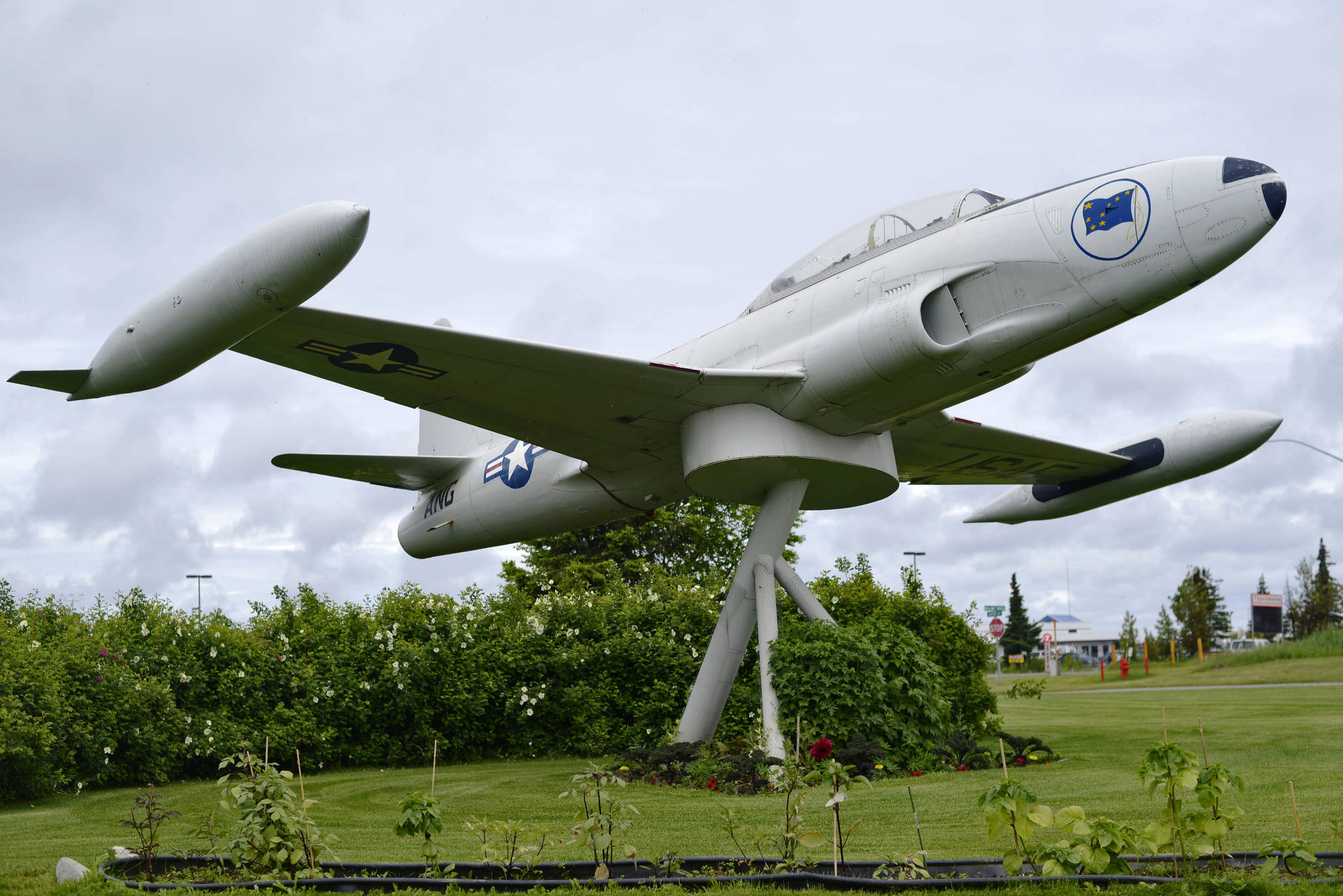The aircraft mounted in the grassy lot in front of the Kenai Municipal Airport — a retired U.S Air Force Lockheed T-33 “Thunderbird”— may be getting a fresh coat of paint this summer, following discussions by the Kenai Airport Commission.
The paint job, not yet scheduled, won’t change the jet’s appearance — per Air Force rules, it must keep its present gray color scheme, said Kenai council member and former Airport Commission chair Henry Knackstedt.
The T-33 is a variant of the first U.S fighter jet, Lockheed’s P-80 “Shooting Star,” built in 1943. The two-seated T-33 training version was meant to help pilots experienced in propellor-driven aircraft learn to fly the new jet fighters. F-80s came to Anchorage with Elmendorf Air Force Base’s 57th Fighter Group in 1948, and a group of red-tailed T-33s flew with Elmendorf’s 5021st Tactical Operations Squadron until the 1980s.
In the early 1990s, as T-33s were being withdrawn from Alaskan Air Force units, then-Kenai Mayor John Williams said he began thinking of preserving one in Kenai.
“Before we became an oil town, Kenai was a very small community with an Federal Aviation Administration outpost, adjacent to Wildwood Air Force Base,” Williams said. “The guys from Elmendorf used to fly down here in those little T-33s on training missions all the time.”
Kenai’s T-33 wasn’t one of the Elmendorf planes. Williams said he’d planned to acquire a T-33 from Elmendorf, but the Air Force ended up selling most of them to foreign militaries. According to a database of aircraft serial numbers, the Kenai aircraft was built in 1952 and retired in February 1983 to the Air Force’s storage yard at Davis-Montham Air Force Base in Arizona. Williams arranged for the Air Force to give it to Kenai for display in April 1990. He’d planned for it to be transported from Arizona to Kenai aboard an Alaska Air National Guard C-130.
“Then came a minor setback known as Operation Desert Storm,” Williams said. “Our people all went over there, they took the C-130s with them, and we had no way to transport.”
The first U.S. invasion of Iraq began in August 1990. After it concluded in February 1991, Williams managed get a nine-person Alaska Air National Guard C-130 crew to retrieve the plane from Arizona in March. Dissassembling the aircraft in Tuscon cost $6,566, with a $799 charge for towing it from the hangar to the transport plane, according to correspondence between Williams and Air Force officials.
Kenai Aviation owner and Kenai Airport Commissioner Jim Bielefeld remembers the T-33 arriving in pieces with bare aluminum, and being stored at the airport’s Civil Air Patrol building before it was assembled, refurbished and mounted in its present position. The aircraft was sandblasted and repainted.
“We got it up on the pedestal, and then I went in and stenciled all the numbers on it. I had a couple of my nephews, who were good artists, paint the polar bear on the front end and did the artwork on the nose,” Williams said. “And I was dealing a lot with prisoners at the time who needed community service, and I had one of those I put to work straightening out the dents and doing the body work.”
The T-33 retains its original Air Force emblems, but also has Alaska National Guard symbols such “ANG” above the tail number and the polar bear nose art, which resembles the insignia of the Alaska Air National Guard’s 144th Airlift Squadron. Williams said the additions were meant to recognize the National Guard’s role in transporting the T-33 to Kenai.
The total cost of refurbishing the plane was $6,169, according to a March 1993 memo from then-Kenai clerk Carol Freas.
Knackstedt said the plane is technically classified as an Air Force museum piece, requiring the city to maintain it. The agreement between Kenai and the Air Force obligates Kenai to “maintain it and make such repairs as are necessary to keep it in a clean and safe condition so that its appearance and use will not discredit the transferor (the Air Force).” Per the agreement, Kenai is required to send a photograph of the plane to the Air Force by Jan. 15 each year to be sure the condition is being met.
According to a plaque at Elmendorf Air Force Base, the T-33 was Alaska’s longest-serving military aircraft. Kenai Airport Commissioner Paul Minelga suggested that the city begin looking into doing some maintenance on its specimen of the plane.
“It’s an artifact that’s central to aviation history in Alaska,” Minelga said. “It’s been on display, and I think it should be kept up. That’s about it.”
Reach Clarion reporter Ben Boettger at benjamin.boettger@peninsulaclarion.com.

